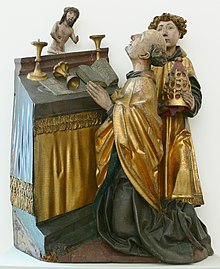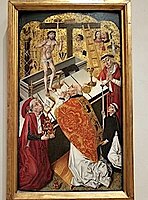Mass of Saint Gregory

The Mass of Saint Gregory is a subject in
History of the story and the image
The earliest version of the story is found in the 8th-century biography of Gregory by Paul the Deacon, and was repeated in the 9th-century one by John the Deacon. In this version, the Pope was saying Mass when a woman present started to laugh at the time of the Communion, saying to a companion that she could not believe the bread was Christ, as she herself had baked it. Gregory prayed for a sign, and the host turned into a bleeding finger.[1]
This story is retained in the popular 13th century compilation the Golden Legend, but other versions conflate the legend with other stories and the finger is changed into a visionary appearance of the whole of Christ on the altar, and the doubter becomes one of the deacons.

The story was hardly seen in art until the
This image seems to have had, perhaps initially only for the Jubilee, a Papal
The
There were several
With the
Gallery
-
Robert Campin, c. 1440, Brussels
-
Anon or Hans Memling
-
The Adoration of the Magi in the Prado
-
Mass of St. Gregory, c. 1490, attributed to Diego de la Cruz (Philadelphia Museum of Art)
-
Aztec feather painting made by or for Diego Huanitzin, nephew and son-in-law of Moctezuma II to present to Pope Paul III, dated 1539.[14]
-
Mass of St. Gregory by Albrecht Dürer
-
As part of a SpanishLast Judgement, 1500–1520
See also
Notes
- ^ Rubin, 121–122
- ^ Shestack, 214
- ^ An early fresco version by Ugolino di Prete Ilario in a cycle of 1357–1363 dedicated to the history of the Eucharist in the Chapel of the Corporal in Orvieto Cathedral has been restored but evidently never showed the Man of Sorrows as the vision.
- ^ Parshall, 58. For a somewhat different chronology, see Pattison, 150
- ^ Schiller, II, 199. The original seems to have been in Rome since the 12th century (Schiller). For the icon now there, see Treasures of Heaven Archived 2011-12-12 at the Wayback Machine
- ^ Rubin, 122 and Shestack, 214
- ^ Parshall, 58
- ^ Kamerick, 169
- ^ For example in the Adriaen Isenbrandt panel in the Getty Museum - link below.
- ^ Last item in this online album
- ^ Field, 22–-230
- ^ Pierce, 95–98, see Shestack, 214 for the print used.
- ^ Parshall, 58 (quoted), and Shestack, 214 (illustrated in both). The indulgences (as with no. 215 below) applied each time a specified collection of prayers, here 7 each of the Creed, Our Father and Hail Mary, were recited in front of the image.
- ^ Pierce, 96
References
- Field, Richard, Fifteenth Century Woodcuts and Metalcuts, National Gallery of Art, Washington (Catalogue), Washington, 1965
- Kamerick, Kathleen; Popular Piety and Art in the late Middle Ages: Image Worship and Idolatry in England, 1350–1500, Palgrave Macmillan, 2002,
- Parshall, Peter, in David Landau & Peter Parshall, The Renaissance Print, Yale, 1996, ISBN 0-300-06883-2
- Pattison George, in W. J. Hankey, Douglas Hedley (eds),Deconstructing Radical Orthodoxy: Postmodern Theology, Rhetoric, and Truth, Ashgate Publishing, Ltd., 2005,
- Pierce, Donna et al.; Painting a New World: Mexican Art and Life, 1521–1821, University of Texas Press, 2004,
- Rubin, Miri, Corpus Christi: The Eucharist in Late Medieval Culture, pp. 120–122, 308–310, Cambridge University Press, 1992,
- ISBN 0-85331-324-5
- Shestack, Alan; Fifteenth Century Engravings of Northern Europe; 1967, National Gallery of Art, Washington (Catalogue), LOC 67-29080
Further reading
- Hans Belting, Das Bild und sein Publikum im Mittelalter: Form und Funktion früher Bildtafeln der Passion, Berlin: Mann, 1981 (also in English)
External links
- biblical-art.com Large selection of images, mostly from manuscripts
- vlaamseprimitieven page on the subject
Individual paintings in depth:
- Cleveland Museum of Art by Hans Baldung Grien1511
- Walker Art Gallery, Liverpool Master of the Aachen Altarpiece, c. 1505
- Getty Museum Three miniatures and a painting






![Aztec feather painting made by or for Diego Huanitzin, nephew and son-in-law of Moctezuma II to present to Pope Paul III, dated 1539.[14]](http://upload.wikimedia.org/wikipedia/commons/thumb/3/30/Huanitzin.jpg/155px-Huanitzin.jpg)

